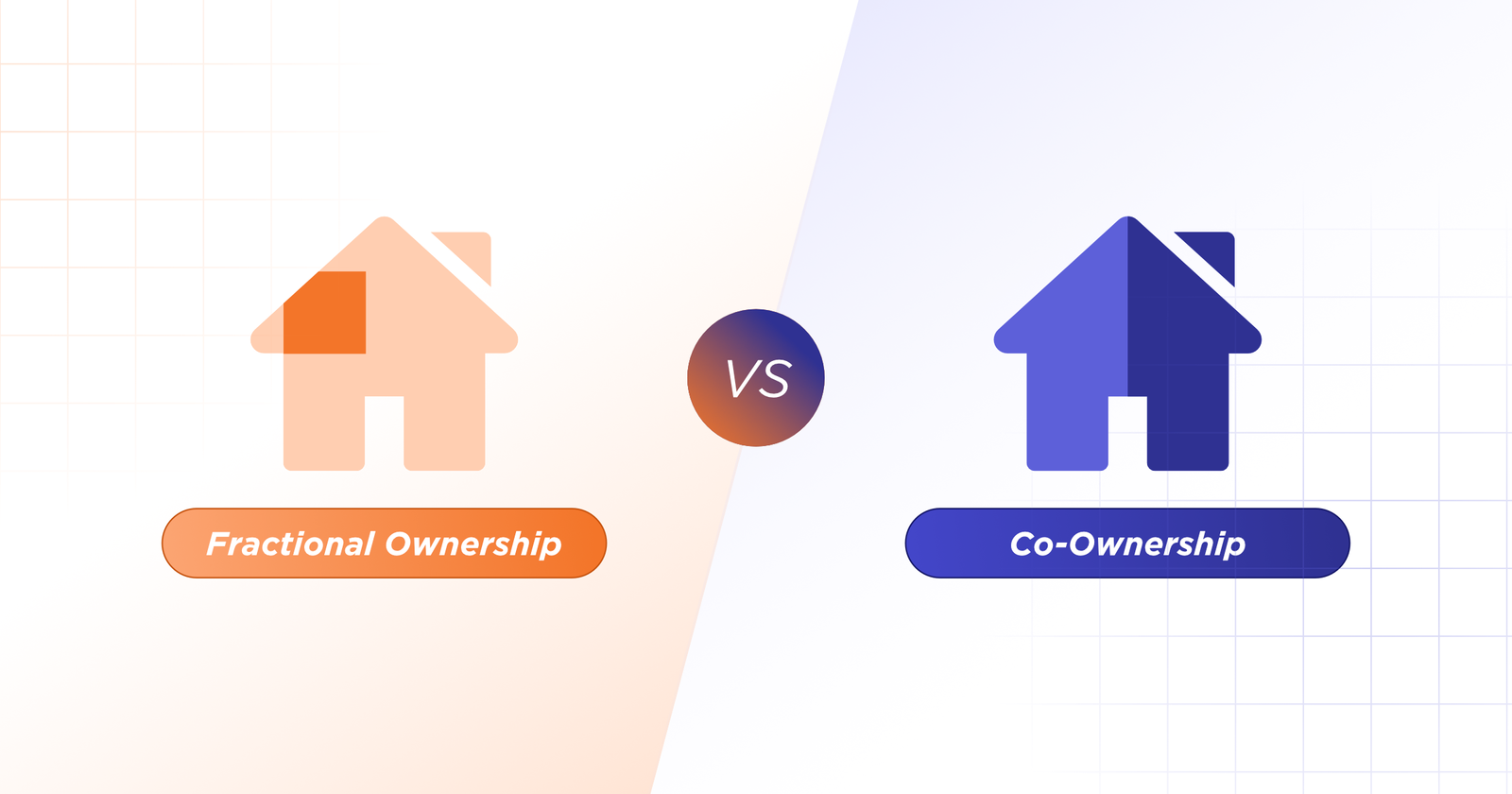As the real estate investment landscape evolves, investors are presented
with various options to participate in property ownership. Two popular
models that often cause confusion are fractional ownership and
co-ownership. This article aims to clarify the difference between
fractional ownership and co-ownership, helping potential investors make
informed decisions about their real estate investments.
Overview of Real Estate Investment Options
Before diving into the specifics of fractional ownership and
co-ownership, it's important to understand the broader context of real
estate investment options available to investors:
- Traditional Full Ownership: Purchasing an entire property
independently. - Real Estate Investment Trusts (REITs): Investing in companies
that own and operate income-generating real estate. - Real Estate Mutual Funds: Pooled investments in real estate
companies or properties. - Co-Ownership: Shared ownership of a property among multiple
parties. - Fractional Ownership: Owning a portion of a property through a
structured investment model.
Among these options, fractional ownership and co-ownership have gained
popularity for their ability to make real estate investment more
accessible. However, they operate on different principles and
structures.
What is Fractional Ownership in Real Estate?
Fractional ownership is a structured investment model that allows
multiple investors to own a portion of a high-value real estate asset.
Key characteristics include:
- Professional Management: Properties are typically managed by a
professional company or platform. - Limited Liability: Investors' liability is usually limited to
their investment amount. - Predefined Usage or Income Distribution: Clear rules for
property usage (in case of vacation homes) or income distribution. - Liquidity Options: Some fractional ownership models offer easier
exit options compared to traditional real estate. - Diversification: Investors can spread their capital across
multiple properties.
Platforms like alt DRX have popularized fractional ownership by
offering:
- Monthly Investment Plans (MIPs) for gradual property ownership
- Access to premium properties with lower capital requirements
- Professional management and regular performance updates
What is Co-Ownership of Property?
Co-ownership, also known as joint ownership, is a more traditional model
where multiple parties share ownership of a property. Key features
include:
- Direct Ownership: Co-owners are directly listed on the property
deed. - Shared Responsibilities: All owners typically share management
responsibilities and costs. - Equal or Unequal Shares: Ownership can be divided equally or in
different proportions. - Right of Survivorship: In some forms of co-ownership, the
surviving owner(s) inherit the deceased owner's share. - Personal Use or Investment: Can be used for personal residence
or as an investment property.
Common types of co-ownership include:
- Joint Tenancy
- Tenancy in Common
- Tenancy by the Entirety (for married couples in some jurisdictions)
Key Differences Between Fractional Ownership and Co-Ownership
Understanding the distinctions between these two models is crucial for
investors. Let's explore the key differences:
1. Ownership Structure
Fractional Ownership:
- Investors own shares in a special purpose vehicle (SPV) or company
that owns the property. - Ownership is typically represented by digital tokens or shares.
- The number of owners can be larger, sometimes in the hundreds.
Co-Ownership:
- Owners are directly named on the property deed.
- Each co-owner has an undivided interest in the entire property.
- Usually involves a smaller number of owners, often family members or
close associates.
2. Management and Decision Making
Fractional Ownership:
- Professional management handles day-to-day operations and
maintenance. - Major decisions are often made by the management company or through
a structured voting process. - Investors have limited involvement in property management.
Co-Ownership:
- Owners are responsible for property management, either handling it
themselves or hiring property managers. - All major decisions typically require agreement among all co-owners.
- More hands-on involvement is required from owners.
3. Financial Aspects
Fractional Ownership:
- Lower entry costs, allowing investment in high-value properties with
less capital. - Costs for maintenance, taxes, and insurance are typically handled by
the management company. - Returns are often distributed based on the fraction owned.
Co-Ownership:
- Usually requires a larger initial investment.
- Owners share all costs associated with the property.
- Profits or losses are divided according to ownership percentages.
4. Liquidity and Exit Options
Fractional Ownership:
- Some platforms offer secondary markets for selling shares.
- Exit processes are often more structured and can be easier than
selling a co-owned property. - Liquidity can vary depending on the specific platform or investment
structure.
Co-Ownership:
- Selling a share typically requires agreement from other co-owners or
partitioning the property. - Less liquid, as finding a buyer for a partial interest in a property
can be challenging. - May require legal processes to exit the investment.
5. Legal and Regulatory Framework
Fractional Ownership:
- Often subject to securities regulations, depending on how the
investment is structured. - Governed by the terms of the investment agreement and platform
rules. - May offer more standardized and transparent legal structures.
Co-Ownership:
- Governed by property laws and the agreement between co-owners.
- May require more complex legal documentation to define rights and
responsibilities. - Disputes can lead to legal complications and potential forced sales.
6. Usage Rights (for Residential Properties)
Fractional Ownership:
- In vacation properties, usage is often allocated through a rotating
schedule or points system. - Clear rules and scheduling for property usage.
Co-Ownership:
- Usage rights are typically negotiated among co-owners.
- Can lead to conflicts if not clearly defined in the co-ownership
agreement.
7. Diversification Potential
Fractional Ownership:
- Allows investors to spread capital across multiple properties more
easily. - Platforms like alt DRX offer diverse property options for portfolio
building.
Co-Ownership:
- Diversification is more challenging due to higher capital
requirements per property. - Typically results in concentration in fewer properties.
Conclusion
Both fractional ownership and co-ownership offer ways to invest in real
estate with shared ownership, but they differ significantly in
structure, management, and investor experience.
Fractional ownership, exemplified by platforms like alt DRX, provides a
more accessible, professionally managed approach to real estate
investing. It's particularly suitable for investors who:
- Seek lower entry costs to premium properties
- Prefer a hands-off investment approach
- Want to diversify across multiple properties
- Value liquidity and structured exit options
Co-ownership, on the other hand, is more appropriate for investors who:
- Have a higher capital to invest
- Prefer direct control over property decisions
- Have a trusted group of co-investors (often family or close
associates) - Are comfortable with a more hands-on approach to property management
When considering the difference between fractional ownership and
co-ownership, investors should carefully evaluate their investment
goals, risk tolerance, desired level of involvement, and capital
availability. Both models have their place in real estate investment
strategies, and the choice between them depends on individual investor
preferences and circumstances.
As the real estate investment landscape continues to evolve,
understanding these distinctions becomes crucial for making informed
investment decisions. Whether opting for the structured approach of
fractional ownership or the direct control of co-ownership, investors
now have more options than ever to participate in the real estate
market.






